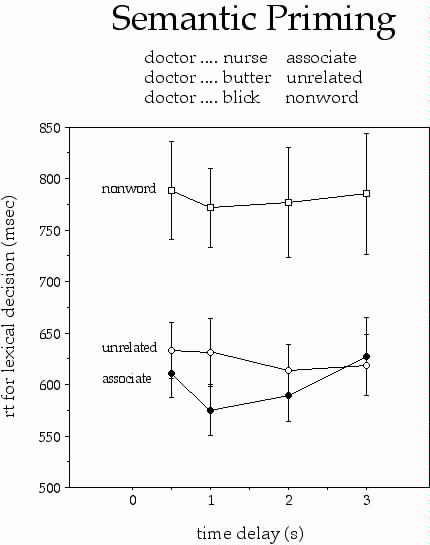Measuring the Course of Activation Produced by Concepts
In the mid 1970’s psychologists found a way to measure the activation of concepts in semantic memory. It is kind of an odd form of measurement but nobody has found a better way to do it in the intervening years. The idea is simple. People are given pairs of words like DOCTOR-NURSE, or DOCTOR-BUTTER or BREAD-BUTTER or BREAD-BLICK. The task, termed lexical decision, is to decide as fast as possible if both letter strings are words or if one of the strings is a nonword like BLICK. The major finding is that people are fastest at reading letter strings and deciding that they are words when the two words are associated. Making a lexical decision about the letter string DOCTOR creates a largely unconscious surge of activation directed towards those parts of semantic memory associated with doctors. This surge is indirectly registered by the behavioral outcome that having seen the word DOCTOR, you will be a little faster to recognize that the letter string NURSE is a word. This is the theory, at least. Thinking about doctors does not activate thoughts of butter and it takes a little longer to recognize that BUTTER is a word. The appearance of personal computers in the 1970’s allowed psychologists to see how activation changed lexical decision times because you need a computer to display all of the letter strings and to obtain precise measurements of reaction time. Association cuts off about 1/10 of a second (100 milliseconds) in the time to make a decision. This may not seem like a big deal, but 1/10 of a second is more than enough time to create trains of thought.
The experiment I did to measure the duration of activation is a slight variation on the original design. Instead of displaying the word pairs at the same time and asking subjects to judge both, I displayed the word pairs one a time with a pause in between. In my design the first string was always a word and the participants had to decide if the second string in each pair was also word. On half the trials the second string was a nonword. On 1/4 of the trials the second word was associated with the first word. And 1/4 of the trials it was not. The time delay between the presentation of the first and second word in each pair is the main variable in this experiment.
The data (averaged over participants) is shown in the adjacent graph and speaks for itself.
On the x-axis is the time delay between the first and second words of each pair. The delays ranged from 1/2 to 3 seconds. On the y-axis is the time (a reaction time, abbreviated as rt) in milliseconds that it took people to decide if the second letter string was a word. First look at the track labeled by nonword. This track is flat within the error bars. It takes about 780 milliseconds to decide that a string is not a word and it does not depend on how long you have been waiting since the first word on that trial appeared. This is because it is not possible to activate a nonword, they don’t mean anything and they are not in semantic memory. The track labeled unrelated gives the reaction times for letter strings that were words but had nothing to do with the first word of the pair. These reactions times are also fairly flat within the error bars. It takes about 625 milliseconds to read a word that is unrelated to what just came before. The reason that this track is flat is that unrelated words are not activated either by the first word in the trial. This is the track corresponding to “doctor – butter” and it makes no difference how long it takes to get “butter” because you were not thinking about it anyway. The key finding is in the track labeled associate. This is the data corresponding to “doctor-nurse”. This data has a parabolic shape that arises from two aspects of semantic activation. Activation is not instantaneous. These data suggest DOCTOR does not fully activate its association network until about a second has passed. At this point associates gain about a 80 millisecond advantage over unrelated words. By 3 seconds, there is no advantage for association at all, the activation has completely decayed. A 3 second interval corresponds to 20 bpm, half the metronome limit. 2 second time delays gives a good estimation for the activation half life,. When NURSE is delayed by 2 seconds, half the priming that DOCTOR created has evaporated, at least as measured by reading time. 2 seconds is also the time delay for notes to begin to lose their musical coherence.


